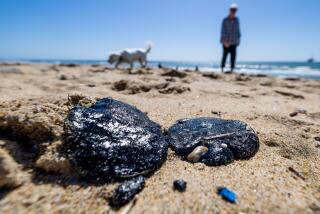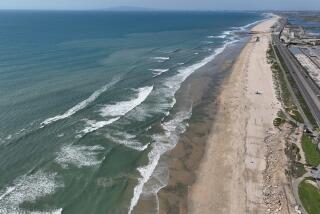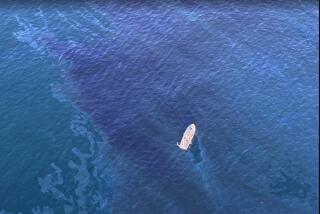Uncertainty grows with oil slick’s size
Reporting from Venice, La., and Washington — With the massive oil slick in the Gulf of Mexico tripling in size in 48 hours, President Obama visited New Orleans on Sunday and promised to “do everything in our power” to mitigate a looming environmental disaster.
Storms briefly grounded Coast Guard planes, but reports of oil hitting land began flowing in, along with confirmed sightings of dead sea turtles, crabs and birds washing ashore in Pass Christian, Miss.
Capricious winds and waves in remote areas confounded efforts to establish exactly when the oil might hit, and Coast Guard officials still had no confirmation late Sunday of landfall.
The coast from Louisiana to Florida braced for the gooey mess to hit barrier islands of the Gulf Islands National Seashore and the sandy beaches and casino enclaves crucial to the region’s tourism industry.
The National Oceanic and Atmospheric Administration announced a 10-day restriction on commercial and recreational fishing from the mouth of the Mississippi River to Florida’s Pensacola Bay. In Alabama, National Guard troops arrived on Dauphin Island to build a berm of sand containers.
BP, the London-based oil company financially responsible for the deep-sea well rupture 50 miles off the coast of Louisiana, was put on the defensive as criticism mounted that too little was done too late to stop the slick.
BP Chairman Lamar McKay, speaking on ABC’s “This Week,” called the accident unforeseeable. He said BP engineers continued to believe that a broken “blowout preventer”— a valve that ensures the well is shut tight in case of an accident — had malfunctioned.
The break has allowed a fountain of oil — officially estimated at 5,000 barrels a day — to gush unchecked from the ocean floor, nearly a mile deep, out of reach of divers and all but the most specialized equipment. McKay compared the company’s efforts to shut the ruptured well to “doing open- heart surgery at 5,000 feet in the dark, with robot-controlled submarines.”
But there were signs that patience with BP’s efforts was growing strained. A day earlier, Louisiana Gov. Bobby Jindal questioned whether BP had sufficient resources to respond to the crisis and declared that Louisiana officials were moving ahead with their own contingency plans.
“We are past the point of waiting,” the statement said.
Obama on Sunday used his most forceful language yet, pledging the full resources of the federal government for as long as it took to fight the massive oil leak that threatened the environment and economy of the Gulf of Mexico region.
“We’re going to do everything in our power to protect our natural resources to compensate those who have been harmed,” Obama said, “to rebuild what has been damaged and help this region persevere like it has done so many times before.”
Obama’s visit coincided with other White House efforts to blunt questions about the federal response. Homeland Security Secretary Janet Napolitano and Interior Secretary Ken Salazar were dispatched to Sunday television talk shows, promising an aggressive response to the spill.
Gulf Coast fishing accounts for 75% of U.S. shrimp production and 20% of U.S. seafood stocks. Obama called the spill a threat to “the heartbeat of the region’s economic life.”
An April 20 explosion and fire later sank the Deepwater Horizon drilling rig, owned by Transocean Ltd. under contract to BP, and left 11 workers missing and presumed dead. Since then, engineers have been working around the clock trying to figure out how to stop what for all practical purposes may be a limitless undersea volcano of oil belching into the deep waters of the gulf.
Pilots operating robotic subs from a nearby ship have failed to fix the broken blowout preventer. A simultaneous effort to drill under the sea floor into the oil well shaft to try to plug it with cement could take three months.
BP offered a glimpse of hope Sunday, suggesting that within six to eight days it could lower huge steel boxes constructed to contain the churning column of oil.
Meanwhile, storms and seas of 7 to 10 feet kept some boats in port and hampered surface efforts as a storm system that had passed through the Los Angeles area several days ago wreaked havoc on the Southeast.
The result was swiftly changing winds, warm bursts of rain and rough water. The unpredictable winds, combined with a dearth of reports from the air, were making it difficult for officials to predict the slick’s growth and movement.
“There’s not a whole lot to do in this weather,” said David Jones, 53, of Mobile, Ala., a supervisor at Oil Recovery Co., which is helping with the spill cleanup.
“When [the oil’s] coming to you and you got it boomed off, you can contain it. The wind is so rough out there, it’s blowing water out of the boom,” he said. Gusts have also made it harder to fly over the spill and determine its size and shape, he said.
Jones, who’s worked in the industry for more than two decades, described the crude as hard to scoop out of the water because it’s so thin. Some sunshine, he said, might evaporate a good portion of it.
The amount of oil spilled so far continued to be debated. BP, which revised its estimates upward after a watchdog group quibbled with its earlier statements, said it had no working flow meters near the sea bottom to measure the flow. Coast Guard officials Saturday said it was difficult to know how much oil has spewed forth since the April 20 blast. But experts say the spill may grow to exceed the 11 million gallons that the Exxon Valdez spilled in Alaska’s Prince William Sound in 1989.
The Obama administration has said no new offshore oil drilling leases will be issued unless rigs have safeguards to prevent a repeat of the explosion. But in a television appearance Sunday on “This Week,” Salazar rejected calls to shut any of the remaining 30,000 drilling rigs in the gulf.
“For us to turn off those spigots would have a very huge impact on America’s economy right now,” Salazar said. “This is an industry that can operate safely.”
Obama, accompanied by White House Chief of Staff Rahm Emanuel, domestic security and counter-terrorism advisor John Brennan and energy advisor Carol Browner, referenced Hurricane Katrina, the 2005 disaster that killed almost 2,000 people and caused tens of billions of dollars in damage. The slow federal response to Katrina helped erode the George W. Bush administration’s political standing.
“I’ve heard already that people are understandably frustrated and frightened, especially because the people in this region have been through worse disasters than anybody should have to bear,” Obama said.
He promised federal assistance, but also fingered BP.
“Let me be clear: BP is responsible for this leak. BP will be paying the bill. But as president of the United States, I’m going to spare no effort to respond to this crisis for as long as it continues,” he said. “And we will spare no resource to clean up whatever damage is caused.”
Times staff writer Jill Leovy in Los Angeles contributed to this report.
More to Read
Sign up for Essential California
The most important California stories and recommendations in your inbox every morning.
You may occasionally receive promotional content from the Los Angeles Times.










